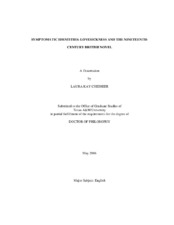| dc.description.abstract | Lovesickness is a common malady in British literature, but it is also an illness
that has been perceived and diagnosed differently in different eras. The nineteenthcentury
British novel incorporates a lovesickness that primarily affects women with
physical symptoms, including fever, that may end in a female character's death. The
fever of female lovesickness includes a delirium that allows a female character to play
out the identity crisis she must feel at the loss of a significant relationship and possibly
of her social status. Commonly conflated with a type of female madness, the nineteenthcentury
novelists often focus less on the delirium and more on the physical symptoms of
illness that affect a female character at the loss of love. These physical symptoms require
physical care from other characters and often grant the heroine status and comfort.
Jane Austen, Elizabeth Gaskell, and Charles Dickens all use subtle variations in
lovesickness to identify the presence or absence of a female character's virtue. Jane
Austen established lovesickness as a necessary experience for female characters, who
choose only if they reveal or conceal their symptoms to a watchful public. Elizabeth
Gaskell established both a comic socially constructed lovesickness in which a female
character can participate if she is aware of popular culture and a spontaneous
lovesickness that affects socially unaware female characters and leads to death. Charles Dickens establishes lovesickness as culturally pervasive by writing a female character
who stages lovesickness for the purpose of causing pain to others and a female character
who is immune to lovesickness and the rhetoric of love, yet is consistently spoken into
others' love stories. Lovesickness becomes a barometer of the soul in several nineteenthcentury
novels by which we read a heroine's virtue or lack of virtue and the depth of her
loss. | en |


